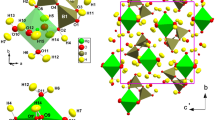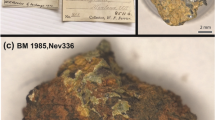Abstract
Buddingtonite (NH4)[AlSi3O8] and its deuterated analogue ND4-buddingtonite (ND4)[AlSi3O8] have been synthesised in 150-mg amounts at 500 and 400 °C and 500 MPa in 5-mm-wide, 4-cm-long Au capsules using René metal hydrothermal autoclaves. The resultant product consists of clumps of monoclinic crystals with diameters of 30–60 μm. The ND4-buddingtonite contains minor amounts of NH4-buddingtonite due to H2 migration across the Au membrane. Using this synthesis technique resulted in >99% pure buddingtonite in 20% of the synthesis runs with the remaining synthesis runs containing very minor tobelite and quartz on the order of a few percent. IR spectra obtained from powdered samples are assigned on the basis of T d symmetry for the ammonium molecule. They show triply degenerate vibrational bands (i.e. ν3 and ν4) and some overtones and combination modes from NH4 + and ND4 +. While T d symmetry for NH4 + in buddingtonite is not completely correct due to distortion of the NH4 + molecule, the non-cubic field is not large enough to cause a substantial splitting in the bands. However, this perturbation is documented in the IR spectra by a substantial increase in the FWHH as well as the occurrence of shoulders on the broadened bands. Rietveld analysis indicates that buddingtonite, like orthoclase, has a monoclinic structure with space group symmetry C2/m. Here, the NH4 + molecule replaces the K+ cation on the nine fold coordinated A site which has m symmetry. Due to the larger size of the NH4 + molecule, the N–O interatomic distances are larger than the K–O distances in pure orthoclase and range from 2.95 to 3.16 Å. This results in an increase in the volume of the polyhedron hosting the NH4 + molecule. Also, in contrast to orthoclase, the polyhedron hosting the NH4 + molecule becomes more regular. The rigid Al, Si tetrahedra of the framework adjust to this expansion of the A site by rotation. This results in larger unit cell parameters for buddingtonite when compared to natural and synthesised potassium feldspars. This increase is especially seen with respect to the lattice constants a and b and the monoclinic angle β which also are found to be extremely variable. In contrast, the c direction remains nearly unchanged. Investigations using IR spectroscopy indicate that it is unlikely that this variation in the a, b and β cell dimensions is caused by incorporation of H3O+ or zeolitic water. Instead, it is more likely that substitution of NH4 + for K+ coupled with Al, Si disorder are the chief contributors to these variations in the unit cell parameters for buddingtonite.
Similar content being viewed by others
Author information
Authors and Affiliations
Additional information
Received: 5 October 1999 / Accepted: 1 November 2000
Rights and permissions
About this article
Cite this article
Harlov, D., Andrut, M. & Pöter, B. Characterisation of buddingtonite (NH4)[AlSi3O8] and ND4-buddingtonite (ND4)[AlSi3O8] using IR spectroscopy and Rietveld refinement of XRD spectra. Phys Chem Min 28, 188–198 (2001). https://doi.org/10.1007/s002690000145
Issue Date:
DOI: https://doi.org/10.1007/s002690000145




